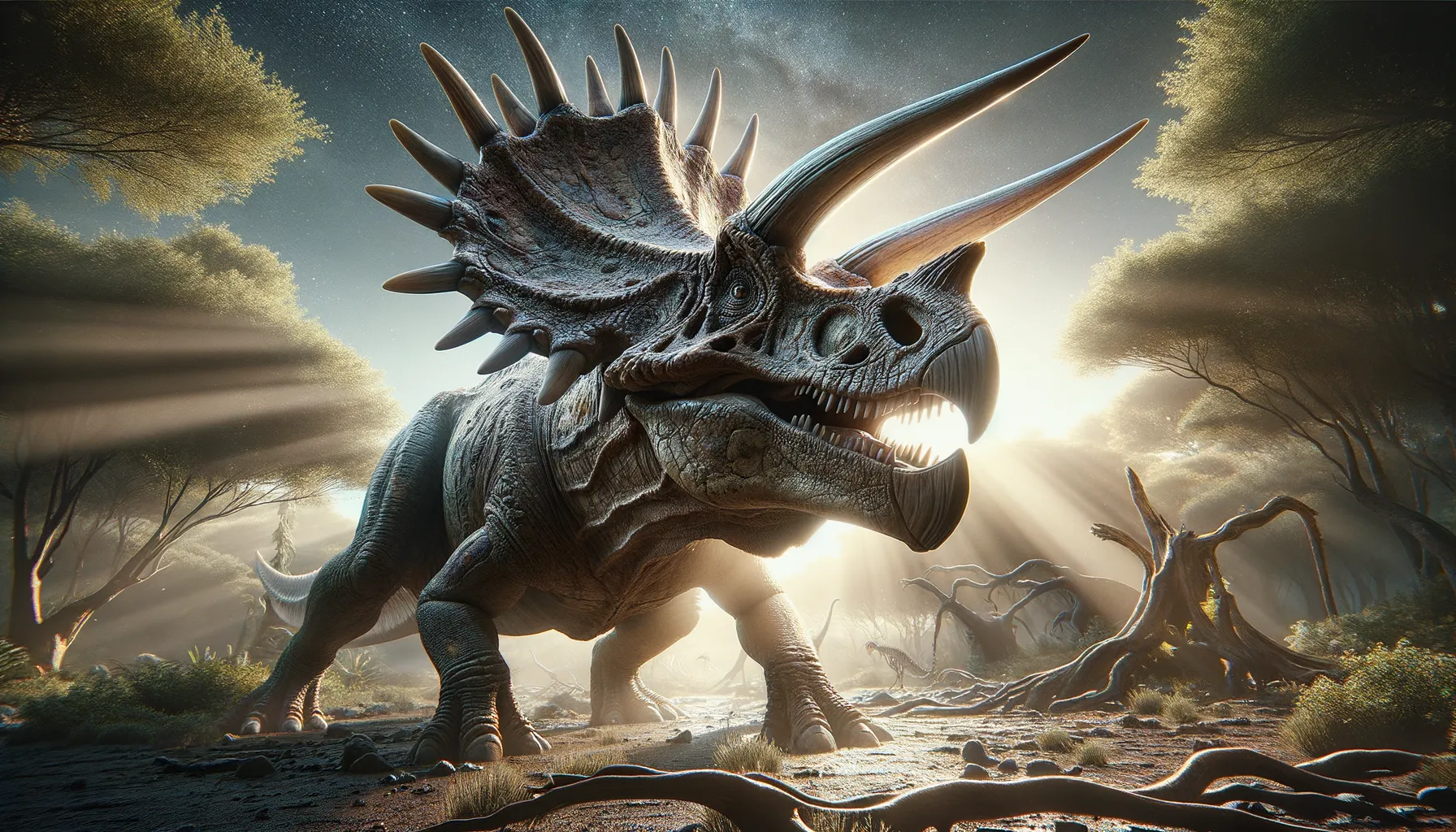
Kosmoceratops
The dinosaur with a crown of horns!
Period
Cretaceous
Length
Approximately 15 to 20 feet long.
Height
Around 6 to 8 feet tall at the hips.
Weight
Approximately 2.5 to 4 tons.
Kosmoceratops was a horned dinosaur known for its flamboyant skull, featuring 15 horns or horn-like structures. It roamed the Earth during the Late Cretaceous period, approximately 76 million years ago, primarily in what is now North America. Its discovery shed light on the diversity and evolution of horned dinosaurs, making it a significant find for paleontologists.
Diet
Kosmoceratops was a herbivore, primarily grazing on low-lying plants. It had a strong beak and dental batteries suitable for processing tough, fibrous vegetation. It likely fed on ferns, cycads, and other prehistoric flora common in its environment.
Hunting
As a herbivore, Kosmoceratops did not hunt other animals but grazed on various plants. Its feeding strategy involved using its parrot-like beak to bite off branches and leaves. Its complex dental structure allowed it to effectively grind and chew tough plant materials.
Environmental challenges
Living during the Late Cretaceous, Kosmoceratops faced challenges such as fluctuating climate conditions and varying availability of plant resources. Monsoonal rains and long dry spells would have impacted the type and quantity of vegetation available. Predators also posed a significant threat, requiring Kosmoceratops to remain vigilant and rely on group living for protection.
Speed
Slow-moving due to its bulk.
Lifespan
Estimated to live around 60-70 years.
First discovery
Discovered in 2006 in southern Utah, USA.
Fun Facts
- Kosmoceratops is known for its unique head features, boasting 15 horns on its skull, more than any other dinosaur discovered so far.
- Kosmoceratops lived around 76 million years ago during the Late Cretaceous period in what is now known as Utah, USA.
- The name Kosmoceratops means 'ornate horned face' due to its elaborate and decorative frill and horns.
- It was a herbivorous dinosaur, meaning it ate plants, and likely roamed the lush forests of ancient North America.
- Kosmoceratops is related to the famous Triceratops, but it's considered one of the most bizarre ceratopsians due to its unusual horn configuration.
- It was a relatively large dinosaur, with an estimated length of about 5 meters (16 feet) and weighing roughly 2 to 2.5 tons.
- The discovery of Kosmoceratops in 2010 helped scientists learn more about the evolutionary diversity of horned dinosaurs.
Growth and Development
From hatching, Kosmoceratops experienced several growth stages before reaching adulthood. Juveniles likely grew rapidly to minimize vulnerability to predators. The intricate horns and frills of Kosmoceratops grew more elaborate with age, possibly playing roles in species recognition or sexual selection.
Habitat
Kosmoceratops inhabited the lush, floodplain environments of what is now North America. This region provided abundant vegetation and relatively mild climates. The landscape included rivers and coniferous forests, which supported a diverse range of plant and animal life.
Interaction with other species
Kosmoceratops shared its environment with various other herbivorous and carnivorous dinosaurs. Its horned frill likely served as both a defensive mechanism and a species-identifying feature among ceratopsians. Socially, Kosmoceratops may have formed herds, providing safety in numbers against predators such as tyrannosaurids.
Natural lifespan
Kosmoceratops likely had a natural lifespan of 60-70 years.
Reproduction
Although direct evidence is scarce, Kosmoceratops likely laid eggs like other dinosaurs. Nesting behavior might have involved communal nesting sites or individual nests. Parental care strategies are unknown, but some ceratopsians may have exhibited protective behaviors towards their young.
Social behaviour
Kosmoceratops may have been a social creature, forming herds or family groups for enhanced protection against predators. Within groups, they might have used visual signals, such as the movement of their elaborate frills, for communication. Cooperation in social behavior could have been crucial for survival in their prehistoric ecosystem.
Fossil locations
Fossils of Kosmoceratops have been predominantly found in the Kaiparowits Formation in Utah, USA. This area falls within the Grand Staircase-Escalante National Monument, which has become renowned for providing diverse and well-preserved dinosaur fossils from the Late Cretaceous period. These discoveries support the theory of a rich and diverse ecosystem once thriving in this region.
